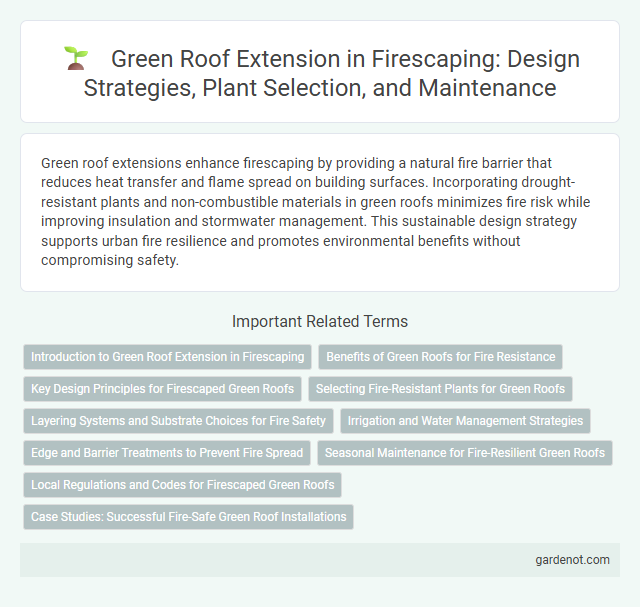Green roof extensions enhance firescaping by providing a natural fire barrier that reduces heat transfer and flame spread on building surfaces. Incorporating drought-resistant plants and non-combustible materials in green roofs minimizes fire risk while improving insulation and stormwater management. This sustainable design strategy supports urban fire resilience and promotes environmental benefits without compromising safety.
Introduction to Green Roof Extension in Firescaping
Green roof extension in firescaping enhances wildfire resilience by integrating fire-resistant vegetation and firebreaks on rooftop gardens. This innovative approach reduces heat absorption and mitigates ember ignition risks, contributing to safer urban environments. Incorporating fire-adaptive plants and non-combustible materials strengthens building defenses against wildfire threats.
Benefits of Green Roofs for Fire Resistance
Green roof extensions significantly enhance fire resistance by creating a natural barrier of moisture-rich vegetation that slows down flame spread and reduces heat intensity. The layers of soil and plants act as insulation, lowering rooftop temperatures and decreasing the risk of ignition during wildfires. Incorporating fire-resistant plant species further boosts the protective qualities of green roofs, making them an effective strategy in firescaping design.
Key Design Principles for Firescaped Green Roofs
Key design principles for firescaped green roofs emphasize the use of fire-resistant plant species such as sedums and succulents that retain high moisture content, reducing ignition risk. Incorporating non-combustible materials in roof layers and maintaining clear firebreak zones enhances fire prevention and limits fire spread. Proper irrigation systems and regular maintenance are essential to sustain plant health and minimize flammable dry vegetation buildup.
Selecting Fire-Resistant Plants for Green Roofs
Selecting fire-resistant plants for green roofs requires prioritizing species with high moisture content and low resin or oil levels, such as sedums, succulents, and certain native grasses. These plants create a natural firebreak by reducing combustible material and slowing fire spread across rooftop landscapes. Incorporating drought-tolerant, fire-retardant vegetation enhances overall green roof resilience while supporting sustainable urban firefighting strategies.
Layering Systems and Substrate Choices for Fire Safety
Green roof extension requires careful layering systems that include a fire-resistant base layer, drainage layer, growing medium, and vegetation that are specifically selected to minimize fire risk. Optimal substrate choices emphasize non-combustible materials with high moisture retention to create a natural barrier against ignition and slow fire spread. Integrating fire-retardant plants and maintaining adequate irrigation further enhance the fire safety of green roofs, reducing the potential damage during wildfire events.
Irrigation and Water Management Strategies
Green roof extension in firescaping utilizes advanced irrigation systems such as drip irrigation and capillary mats to efficiently deliver water directly to plant roots, optimizing water use and reducing runoff. Incorporating rainwater harvesting and smart moisture sensors enables real-time monitoring and adaptive irrigation scheduling, ensuring consistent soil moisture levels that enhance plant resilience against fire stress. These water management strategies improve drought tolerance and support sustainable green roofs, contributing to fire-resistant landscapes and urban heat island mitigation.
Edge and Barrier Treatments to Prevent Fire Spread
Edge and barrier treatments in green roof extensions are critical for preventing fire spread by creating defensible zones between combustible vegetation and structural elements. Fire-resistant materials such as metal edging, gravel borders, and concrete curbs act as physical barriers to curb ember travel and flame propagation. Proper maintenance of these firebreaks, including regular removal of dead plant matter and debris, ensures sustained fire resilience and compliance with fire safety regulations.
Seasonal Maintenance for Fire-Resilient Green Roofs
Seasonal maintenance for fire-resilient green roofs involves regular inspection and removal of dead vegetation to minimize fuel loads that could ignite during dry periods. Implementing targeted irrigation schedules keeps plants healthy and less flammable, especially in hot, arid seasons. Clearing debris and ensuring firebreaks between roof sections significantly reduces the risk of fire spreading across the green roof.
Local Regulations and Codes for Firescaped Green Roofs
Local regulations and building codes for firescaped green roofs vary significantly by region, often emphasizing fire-resistant vegetation and materials to minimize wildfire risk. Compliance with standards such as the International Fire Code (IFC) and local fire safety ordinances ensures proper installation and maintenance of fire-resilient plant species and irrigation systems. Understanding jurisdiction-specific requirements is essential for designing green roof extensions that enhance fire protection while promoting sustainability and urban heat reduction.
Case Studies: Successful Fire-Safe Green Roof Installations
Case studies highlight successful fire-safe green roof installations that integrate drought-resistant, fire-retardant plant species and layered, non-combustible substrates to reduce ignition risk. Notable projects demonstrate compliance with local fire codes and use of advanced irrigation systems, enhancing resilience during wildfire events. Data-driven outcomes show significant reduction in fire spread potential while promoting urban biodiversity and thermal insulation benefits.
Green roof extension Infographic

 gardenot.com
gardenot.com